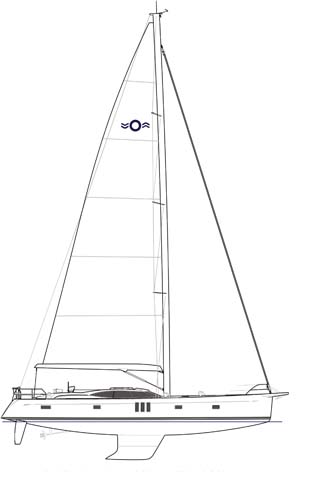Accommodation: Where to sleep?
Oyster’s modern raised saloon format is impressive. The triple vertical ‘seascape’ hull portlights, together with the generous coachroof windows, create a fabulously light and well-connected saloon.
Two of the large, forward-looking coachroof windows open out for ventilation. The test boat also had traditional dorades (in slight contrast to the flush foredeck design).
I was consistently drawn to the practical features of the 675. Fuel separators, hydraulics, plumbing and the watermaker are all housed centrally in plentiful space below the saloon sole, for example. The navstation is offset at 45 degrees, which makes it easy to monitor the large bank of electronics mounted on the adjacent bulkhead. And the wet hanging locker is located beneath the companionway steps, warmed by the engine room directly behind. I did however find the space between saloon table and port berth a little too large when trying to venture forward while the boat was heeled.
The galley is superb: super-spacious yet practically laid out with deep fiddled work surfaces and athwartships domestic-size fridge-freezer. The double sink is located inboard beneath cupboards that will neatly swallow all the crockery and glassware behind their sliding doors. Despite a washing machine and dishwasher housed in the galley, there is still ample stowage. Additional refrigeration space is built in to the saloon table and the cockpit table, plus there is a drinks cooler beneath the forward berth – this owner has named his yacht after a particular South African white wine after all.

The test boat was fitted with a forward guest en-suite cabin. This can be enlarged and specified as the master cabin.
Forward of the saloon, our test boat was fitted with a day heads and shower to port for the use of both the compact double cabin opposite and the Pullman aft. The master cabin is astern while the forward en-suite guest cabin looks suitably plush with an island berth and generous stowage.
The option to locate the master suite ahead of the mast offers greater privacy for owners who spend a lot of time moored stern-to. However, anyone who has spent time in the aft cabin of an Oyster will understand why the yard has not felt the need to offer anything different before. Factor in the vertical hull windows offered in the aft cabin of the 675, which provide it with so much natural light, and it is hard to imagine anyone preferring the forward master option.
The wide variety of layout options range from two cabins to four. “Some want to pack it with cabins, while others want to keep the volume for longer stints on board,” Tydeman explained. There is the option to have a compact crew cabin in the bow, but for anything other than temporary occasions, it would be more reasonable for a professional crew to use a Pullman cabin.
The verdict
There is a boom in the market for yachts in the 60-70ft range, but Oyster is already well ahead of the curve here. It is a company that has long been comfortable building in the 60-90ft sector. At this end of the scale, its competition, and thus the choice for potential owners, is narrow. Few, if any, yards are capable of producing genuine series-built bluewater cruisers at this size. And few are able to compete with Oyster in terms of ability, engineering and quality.
Compared to the 625 and 575, the extra size of the 675 brings not only extra space and speed, but also a lot more boat to maintain. So the key decision, especially for those who still want to sail privately, will be whether to employ a crew member and for how long. But that would certainly be a nice decision to have to make.
Oyster Yachts: made in England
A visit to Oyster Yachts’ Southampton facility confirms this company’s dominance in the 80ft sector: the five bays were full of 825s and 885s – and the sixth 825, Enso, was being commissioned afloat. Apart from vacuum infused bulkheads and carbon-capped frames, construction techniques remain relatively conventional with a reassuringly belt-and-braces approach.

Oyster Yachts Southampton
The 675 and 745 can be built either in Southampton, or in Norfolk where the 475 to 625 models are built. Oyster employs about 400 people in total with 320 on the shop floor, capable of producing 18-20 boats a year. Construction time varies from around nine months for a 475 to 16 months for a 885.
Oyster 675: Specifications
LOA: 21.03m (69ft 0in)
LWL: 18.16m (59ft 7in)
Beam (max): 5.65m (18ft 6in)
Draught: 2.95m (9ft 8in)
Displacement (lightship): 37,500kg (82,673lb)
Ballast: 11,300kg (24,912lb)
Sail Area (100% foretriangle): 235.5sq m (2,535sq ft)
Engine: 180hp Volvo Penta saildrive
Water: 1,550lt (341gal)
Fuel: 1,900lt (418gal)
Sail Area-Displacement ratio: 21.4
Displacement-LWL ratio: 174
Price (ex VAT): £2,480,000
Design: Humphreys Yacht Design


The two-berth Pullman cabin

The owner of this first 675 requested steps in the transom so he could easily board the dinghy, which will be stowed on davits. The transom includes a large swim platform that lowers on struts.

The twin rudders provided good feedback in anything above 7 knots.

The uncluttered cockpit forward of the binnacles, beneath the optional bimini.

The superbly spacious galley features a domestic-size fridge-freezer.

The navstation is angled at 45 degrees with space for a rack of electronics.





